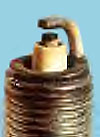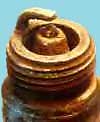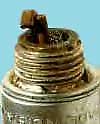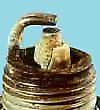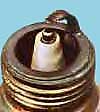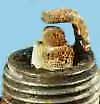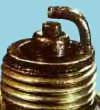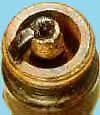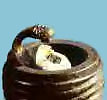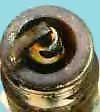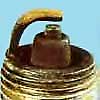Spark plug installation:
Torque is one of the
most critical aspects of spark plug installation. Torque directly
affects the spark plugs' ability to transfer heat out of the
combustion chamber. A spark plug that is under-torqued will not be
fully seated on the cylinder head, hence heat transfer will be
slowed. This will tend to elevate combustion chamber temperatures to
unsafe levels, and pre-ignition and detonation will usually follow.
Serious engine damage is not far behind.An over-torqued spark
plug can suffer from severe stress to the Metal Shell which in turn
can distort the spark plug's inner gas seals or even cause a
hairline fracture to the spark plug's insulator...in either case,
heat transfer can again be slowed and the above mentioned conditions
can occur.
The spark plug holes must always be cleaned prior to
installation, otherwise you may be torquing against dirt or debris
and the spark plug may actually end up under-torqued, even though
your torque wrench says otherwise. Of course, you should only
install spark plugs in a cool engine, because metal expands when its
hot and installation may prove difficult. Proper torque specs for
both aluminum and cast iron cylinder heads are listed below.
|
|
|
|
|
|
Flat seat type
(with gasket)
|
18 ø mm
|
25.3~32.5
|
25.3~32.5
|
| " |
14 ø mm
|
18.0~25.3
|
18.0~21.6
|
| " |
12 ø mm
|
10.8~18.0
|
10.8~14.5
|
| " |
10 ø mm
|
7.2~10.8
|
7.2~8.7
|
| " |
8 ø mm
|
-- |
5.8~7.2
|
|
Conical seat type (without gasket)
|
18 ø mm
|
14.5~21.6
|
14.5~21.6
|
|
Conical seat type (without gasket)
|
14 ø mm
|
10.8~18.0
|
7.2~14.5
|
Gapping
Since the gap size has a direct affect on the spark plug's tip
temperature and on the voltage necessary to ionize (light) the
air/fuel mixture, careful attention is required. While it is a
popular misconception that plugs are pre-gapped from the factory,
the fact remains that the gap must be adjusted for the vehicle that
the spark plug is intended for.
Q:
How often should I replace my spark plugs?
A: Unfortunately, there is no single answer to this
question. As spark plugs grow older, they lose their sharp edges as
material from the center and ground electrodes is slowly eroded
away. As the gap between these two points grows, the voltage
required to bridge the gap increases proportionately. Even the best
ignition systems will be strained to supply enough voltage to
completely burn the fuel. It is at this point, when fuel is being
left unburned, that the time has come to change spark plugs.
Replacing worn out spark plugs with new ones (with sharp new
edges) effectively restores the ignition system's efficiency.
Misfires are reduced, power is restored, economy of operation is
enhanced and emissions are reduced.
The best guide is the manufacturer's recommendation for your
vehicle, as this particular service varies from brand to brand and
model to model. In the absence of this information or in conjunction
with it, you can rely on the advice of a mechanic who is familiar
with your type of vehicle. In the best of all worlds, this would be
a mechanic who is also familiar with the vehicle you own. If you
find a good mechanic, whether dealer or independent, stick with him.
The better he knows your personal vehicle, the better he will be
able to diagnose and service it. The end result is very much like a
doctor-patient relationship and, in the long run, you will have a
healthier vehicle.
Q:
What do the numbers and letters in a part number
represent?
A: The various numbers and letters in a spark plug code or
identification number basically identify the features and functions
of a particular plug. Included would be information such as plug
type, heat rating, construction, thread diameter, thread reach and
firing end construction.
Click on the link below to download a guide that will help you
decipher the various NGK alpha-numeric combinations. You will need
to open it with Adobe Acrobat Reader. If you do not already have
Acrobat Reader installed on your computer, we've provided a link to
the free download area for your convenience.
Download the part number guide
Download Adobe Acrobat Reader (Free)
|


 Look at the spark plug porcelain for
the color and condition of it. Plug colors can tell you how the engine is
running and can be very important. Plugs change colors and the different
colors can explain such things as if the engine is running too hot or if
the engine is worn.
Look at the spark plug porcelain for
the color and condition of it. Plug colors can tell you how the engine is
running and can be very important. Plugs change colors and the different
colors can explain such things as if the engine is running too hot or if
the engine is worn. 